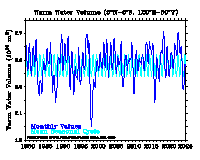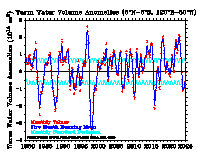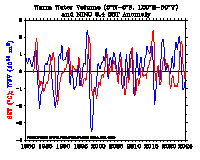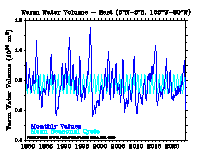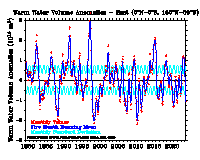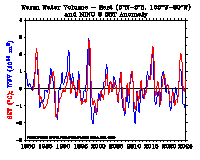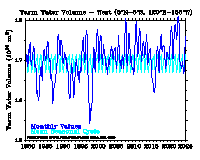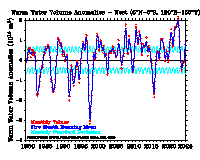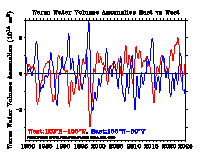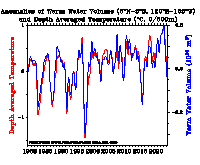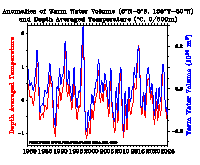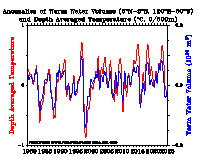Upper Ocean Heat Content and ENSO
See realtime graphics and data dowload below
El Niño/Southern Oscillation (ENSO) variability is intimately linked to alternating stages of oceanic heat content build-up and discharge in the equatorial Pacific (Wyrtki, 1985; Cane et al, 1986; Zebiak, 1989). Jin (1997) elegantly described the relationships between heat content, sea surface temperature and zonal wind stress in his "Recharge Oscillator" theory of ENSO. Recent studies of oceanic and atmospheric variability have confirmed these relationships and elaborated on their implications for understanding the dynamics of the ENSO cycle (Meinen and McPhaden, 2000; Kessler, 2002; Trenberth et al, 2002).
The predictability of ENSO likewise derives from deterministic wind-driven ocean dynamics that govern the slowly evolving heat content of the upper ocean (Latif et al, 1998). Inclusion of upper ocean temperature data in ENSO prediction schemes significantly improves forecast skill at multi-season lead times, particularly across the spring predictability barrier (Ji and Leetmaa, 1997; Clarke and Van Gorder, 2003; McPhaden, 2003). Equatorial Pacific heat content also is a useful predictor of Indian summer monsoon rainfall (Rajeevan and McPhaden, 2004).
A convenient index of equatorial Pacific heat content is the integrated warm water volume (WWV) above the 20°C isotherm between 5°N-5°S, 120°E to 80°W Meinen and McPhaden (2000). We have derived monthly WWV values from the temperature analyses of the Bureau National Operations Centre (BNOC) at the Australian Bureau of Meteorology. The analyses are based on temperature profiles from TAO moorings, Argo floats and XBTs. Monthly anomalies are computed by removing a mean seasonal cycle for a base period of 1981-2010.
The WWV estimates made available on this page are updated weekly. All estimates can be downloaded as ASCII files and are plotted below. Also available are WWV values for just the eastern and western halves of the Pacific basin, variability of which is discussed in Meinen and McPhaden (2000).
For some purposes (e.g., model validation), it may be easier to use an equivalent measure of upper ocean heat content, namely depth averaged temperature in the upper 300 m (designated T300). The correlation between monthly means and anomalies of WWV and T300 is > 0.9. T300 values are also made available on this page over the same latitude and longitude ranges as WWV.
We thank the Bureau National Operations Centre (BNOC) at the Australian Bureau of Meteorology. Their temperature analyses are available at http://www.bom.gov.au/oceanography/oceantemp/pastanal.shtml
Please email the Supervisor for Oceanographic Systems (sros@bom.gov.au) for further details, and also see
Smith, N.R., 1995. The BMRC ocean thermal analysis system, Aust. Met. Mag. 44, 93-110
Please acknowledge the TAO Project Office of NOAA/PMEL if you use WWV or T300 estimates in publications or presentations. We would also appreciate receiving a preprint and/or reprint of publications utilizing these data for inclusion in the TAO bibliography. Relevant publications should be sent to:
TAO Project Office
NOAA/Pacific Marine Environmental Laboratory
7600 Sand Point Way NE
Seattle, WA 98115
For further information, contact Michael.J.McPhaden@noaa.gov.
Realtime graphics and data
References
Cane, M. A., S. E. Zebiak, and S. C. Dolan, 1986: Experimental forecasts of El Niño. Nature, 321, 827-832.
Clarke A. J., and S. Van Gorder, 2003: Improving El Niño prediction using a space-time integration of Indo-Pacific winds and equatorial Pacific upper ocean heat content, Geophys. Res. Lett., 30(7), 1399, doi:10.1029/2002GL016673.
Ji, M., and A. Leetmaa, 1997: Impact of data assimilation on ocean initialization and El Niño prediction, Mon. Weather Rev., 125, 742-753.
Jin, F. F., 1997: An equatorial recharge paradigm for ENSO. part I: Conceptual model, J. Atmos. Sci., 54, 811-829.
Kessler, W. S., 2002: Is ENSO a cycle or a series of events?, Geophys. Res. Lett., 29(23), 2125, doi:10.1029/2002GL015924.
Latif, M., D. Anderson, T. Barnett, M. Cane, R. Kleeman, A. Leetmaa, J. O'Brien, A. Rosati, and E. Schneider, 1998: A review of the predictability and prediction of ENSO, J. Geophys. Res., 103, 14,375 14,393, 1998.
McPhaden, M.J., 2003: Tropical Pacific Ocean heat content variations and ENSO persistence barriers, Geophys. Res. Lett., 30(9), 1480, doi:10.1029/2003GL016872.
Meinen, C.S. and M.J. McPhaden, 2000: Observations of warm water volume changes in the equatorial Pacific and their relationship to El Niño and La Niña, J. Clim., 13, 3551-3559.
Rajeevan, M. and M.J. McPhaden, 2004: Tropical Pacific upper ocean heat content variations and Indian summer monsoon rainfall, Geophys. Res. Lett., 31, L18203, doi:10.1029/2004GL020631.
Smith, N. R., 1995: An improved system for tropical ocean sub-surface temperature analyses, J. Atmos. Oceanic Technol., 12, 850-870.
Trenberth, K. E., J. M. Caron, D. P. Stepaniak and S. Worley, 2002: Evolution of El Niño Southern Oscillation and global atmospheric surface temperatures. J. Geophys. Res., 107(D8), 4065,10.1029/2000D000298.
Wyrtki, K., 1985: Water displacements in the Pacific and the genesis of El Niño cycles. J. Geophys. Res., 90, 7129-7132.
Zebiak, S., 1989: Ocean heat content variability and ENSO cycles, J. Phys.Oceanogr., 19, 475-485.



